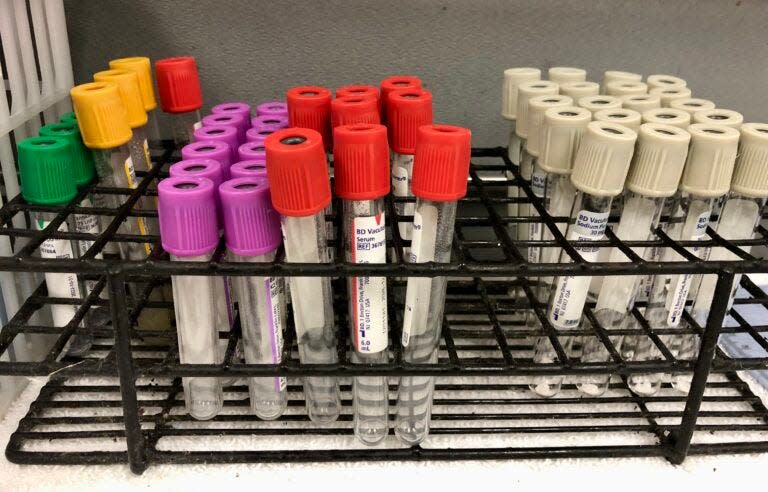Nex Benedict autopsy: What to know about Oklahoma medical examiner's office, toxicology
Questions still remain after the release of an autopsy summary for an Oklahoma teen whose death sparked national outrage and concerns about bullying in Oklahoma schools.
Nex Benedict was pronounced dead Feb. 8, one day after being injured in an altercation inside an Owasso High School bathroom. A summary autopsy report concluded the 16-year-old died of toxicity from diphenhydramine, an antihistamine, and fluoxetine, an anti-depression medication. The medical examiner ruled the teen died by suicide, and said the full report would be released in about 10 business days.

Nex's family said they had been bullied in the past over their gender expansive identity, which did not align with societal stereotypes. Nex, a descendant of the Choctaw Nation, used the pronouns he, him, they and them, friends and relatives have said.
Here's what you need to know about Oklahoma's medical examiner office, who performed the autopsy and what goes into toxicology testing.
What to know about Oklahoma's chief medical examiner office
Oklahoma's Office of the Chief Medical Examiner is responsible for investigating sudden, violent, unexpected and suspicious deaths.
The autopsy reports created by the medical examiner's office are often critical evidence and expert testimony in both criminal and civil legal proceedings.
The time it takes for autopsy reports to be completed varies, from weeks to months in some cases.
What to know about Oklahoma's Toxicology Laboratory
Oklahoma's Toxicology Laboratory serves both the Oklahoma City and Tulsa medical examiner's offices and is responsible for analytical testing, records maintenance and review of analytical testing for more than 5,000 cases annually.
The laboratory is accredited by the American Board of Forensic Toxicology.
Who is the Oklahoma chief medical examiner?
Oklahoma's chief medical examiner is Eric Pfeifer, who received his Doctor of Medicine degree at the Medical College of Georgia at Augusta University, according to his LinkedIn.
However, the office has 14 forensic pathologists to perform the autopsies under its jurisdiction, all medical doctors with either Doctor of Medicine or Doctor of Osteopathic Medicine degrees.
Who performed Nex Benedict's autopsy?
The pathologist who performed Benedict's autopsy was Dr. Ross Miller, who works at the chief medical examiner's Tulsa office. He is licensed through the Oklahoma Medical Board.
According to a bio on the medical examiner's website, Miller has been with the state medical examiner's office since July 2015. He obtained his medical degree from the University of Nebraska in 2010, and completed a Forensic Pathology Fellowship at the Jackson County medical examiner’s office in Kansas City, Missouri.
Miller is board certified in Anatomic and Forensic Pathology, and is an active member of the National Association of Medical Examiners, American Academy of Forensic Sciences, American Society of Clinical Pathology, and College of American Pathologists.
Since 2018, he has directed the office's Forensic Pathology Fellowship Program.
How long do toxicology reports usually take?

Benedict's autopsy was performed on Feb. 9 by the medical examiner's office, and the summary autopsy results were publicized on March 13, nearly five weeks later.
An autopsy with extensive toxicology testing can take weeks, and sometimes months, to be completed. But four to six weeks is "pretty standard," according to WebMD.
The timeline can vary because often there are a lot of specimens that need to be tested for. New information can be discovered through investigations that require even more substances requiring testing, WebMD noted.
When an initial toxicology screening reveals the presence of a substance, more sophisticated and sensitive testing is needed, which adds to the time. These tests can tell forensic pathologists the exact concentration of a substance, and can help them determine whether two substances found together produced an exaggerated effect.
How is toxicity determined?
Once all testing is finished, the collaboration of toxicologists, chemists and pathologists is required to analyze and interpret results.
Those interpreting the toxicology results must determine whether the concentration of a substance was a therapeutic dose, a toxic dose or a lethal dose — and then whether they contributed to the death or caused the death.
Benedict's cause of death was determined to be toxicity from diphenhydramine and fluoxetine.
According to the Centers for Disease Control and Prevention, toxicity "describes the degree to which a substance is poisonous or can cause injury. The toxicity depends on a variety of factors: dose, duration and route of exposure, shape and structure of the chemical itself, and individual human factors."
This article originally appeared on Oklahoman: Nex Benedict autopsy: What to know about Oklahoma medical examiner

